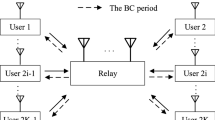Abstract
Power allocation is a key technique to exploit the benefits of cooperative relaying. In this paper, we investigate the effect of shadowing on the power allocation of amplify-and-forward cooperative relaying systems. Considering the joint effects of path loss, correlated shadowing and flat Rayleigh fading, the approximate outage probability at high signal-to-noise ratio (SNR) is first derived. Then we solve the power allocation problem by minimizing the approximate outage probability subject to a total power constraint. It is shown by the analytical results that the correlation coefficients and the standard deviations of shadowing have significant impacts on the power allocation. The simulation results show that the proposed power allocation scheme yields about 2 dB SNR gain compared to the equal power allocation in the high SNR regime.





Similar content being viewed by others
References
Laneman, J. N., Tse, D. N. C., & Wornell, G. W. (2004). Cooperative diversity in wireless networks: Efficient protocols and outage behavior. IEEE Transaction on Information Theory, 50(12), 3062–3080.
Nabar, R. U., Bölcskei, H., & Kneubühler, F. W. (2004). Fading relay channels: Performance limits and space-time signal design. IEEE Journal on Selected Areas in Communications, 22(6), 1099–1109.
Hoymann, C., Chen, W., Montojo, J., Golitschek, A., Koutsimanis, C., & Shen, X. (2012). Relaying operation in 3GPP LTE: Challenges and solutions. IEEE Communication Magazine, 50(2), 156–162.
Host-Madsen, A., & Zhang, J. (2005). Capacity bounds and power allocation for wireless relay channels. IEEE Transaction on Information Theory, 51(6), 2020–2040.
Farhadi, G., & Beaulieu, N. C. (2009). Power-optimized amplify-and-forward multi-hop relaying systems. IEEE Transaction on Wireless Communications, 8(9), 4634–4643.
Ahmed, N., Khojastepour, M. A., Sabharwal, A., & Aazhang, B. (2006). Outage minimization with limited feedback for the fading relay channel. IEEE Transaction on Communications, 54(4), 659–669.
Hasna, M. O., & Alouini, M.-S. (2004). Optimal power allocation for relayed transmissions over rayleigh-fading channels. IEEE Transaction on Wireless Communications, 3(6), 1999–2004.
Fareed, M. M., & Uysal, M. (2008). BER-optimized power allocation for fading relay channels. IEEE Transaction Wireless Communications, 7(6), 2350–2359.
Khabbazibasmenj, A., & Vorobyov, S. A. (2011). Power allocation based on SEP minimization in two-hop decode-and-forward relay networks. IEEE Transaction on Signal Processinig, 59(8), 3954–3963.
Ikki, S. S., & Aïssa, S. (2011). A study of optimization problem for amplify-and-forward relaying over Weibull fading channels with multiple antennas. IEEE Communications Letters, 15(11), 1148–1152.
Tabataba, F. S., Sadeghi, P., & Pakravan, M. R. (2011). Outage probability and power allocation of amplify and forward relaying with channel estimation errors. IEEE Transaction on Wireless Communications, 10(1), 124–134.
Shi, Y., Wang, J., Letaief, K. B., & Mallik, R. (2009). A game-theoretic approach for distributed power control in interference relay channels. IEEE Transactions on Wireless Communications, 8(6), 3151–3161.
Ren, S., & Schaar, M. (2010). Distributed power allocation in multi-user multi-channel cellular relay networks. IEEE Transactions on Wireless Communications, 9(6), 1952–1964.
Szyszkowicz, S. S., Yanikomeroglu, H., & Thompson, J. S. (2010). On the feasibility of wireless shadowing correlation models. IEEE Transactions on Vehicular Technology, 59(9), 4222–4236.
Graziosi, F., & Santucci, F. (2002). A general correlation model for shadow fading in mobile radio systems. IEEE Communication Letter, 6(3), 102–104.
Agrawal, P., & Patwari, N. (2009). Correlated link shadow fading in multi-hop wireless networks. IEEE Transaction on Wireless Communications, 8(8), 4024–4036.
Senarath, G., Tong, W., & Zhu, P. (2007). Multi-hop relay system evaluation methodology (channel model and performance metric). IEEE 802.16j-06/013r3.
Tse, D., & Viswanath, P. (2005). Fundamentals of wireless communication. New York: Cambridge University Press.
Ray Liu, K. J., Sadek, A. K., Su, W., & Kwasinski, A. (2009). Cooperative communications and networking. New York: Cambridge University Press.
Boyd, S., & Vandenberghe, L. (2004). Convex optimization. New York: Cambridge University Press.
Acknowledgments
This work was supported by the National Natural Science Foundation of China (61271164, U1035002/L05, 61001087, 61101034) and the Fundamental Research Funds for the Central Universities (ZYGX2011YB003).
Author information
Authors and Affiliations
Corresponding author
Rights and permissions
About this article
Cite this article
Han, L., Shao, S., Shen, Y. et al. Power Allocation for Amplify-and-Forward Relaying with Correlated Shadowing. Wireless Pers Commun 74, 427–438 (2014). https://doi.org/10.1007/s11277-013-1295-5
Published:
Issue Date:
DOI: https://doi.org/10.1007/s11277-013-1295-5




